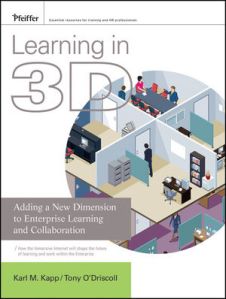by Rich Mesch
[This is part 2 of series that started here. I met Dr. Glynn Cavin at this year’s ASTD TechKnowledge conference. He shared with me some of the work he is doing using Virtual Immersive Environments, and was good enough to allow me to interview him for this article.—RM]

Is your training a matter of life and death?
For Dr. Glynn Cavin, it is. Glynn is the Director of the Transportation Training and Education Center at Louisiana State University and a PhD in Human Resource Education and Workforce Development. One of his responsibilities is training road maintenance crews in Louisiana. Road crew errors have resulted in thousands of injuries and deaths over the years. How could he turn those numbers around?
A former Air Force Colonel, Glynn spent 24 years in the military. His military experience taught him that he needed to be out there, working side-by-side with the people he was responsible for, and to get to know them. "It felt like training had two different camps," says Glynn. "There was more sophisticated training for professionals like engineers, but only classroom training for the highway maintenance crews. There's nothing wrong with classrooms, but a lot of the crew members were intimidated by the classroom. It isn't their natural setting, for many of them it's an environment where they haven't historically been successful, and it isn't really relevant to their job. And then we wonder why they aren't getting it."
As a curious learning professional, Glynn had spent some time in Second Life, and found himself wondering if Virtual Immersive Environments (VIEs) might be an option for him. After all, road crews didn't work in classrooms; they worked out on roads and highways. Although the classroom training provided opportunities for practice, it wasn’t very realistic; there’s a big difference between trying a skill in the classroom versus doing it in the midst of busy traffic, noisy construction, and unpredictable weather. What if learners could practice in a safe environment that replicated many of the auditory, visual, and emotional cues they’d experience in real life?
“There’s no way to experiment or practice in the classroom,” says Glynn. “You learn the basics of work zone safety, and next thing, you’re out in the real work zone with cars whizzing by at 50 miles per hour. At least if you get clipped by a car in the virtual world, the only thing that gets hurt is your feelings.”
“We don't know a lot yet about how people learn virtually,” Glynn adds. “When the virtual world has the same cues as the real world, then those cues should help in the recall process when it's time to subconsciously recall that learning. We are looking to get the ‘Sense of Self’ and the ‘Power of Presence’ that Kapp & O’Driscoll talk about.”
Glynn set out to create a training experiment, where he would compare the effectiveness of blended training using both classroom and a Virtual Immersive Environment with training that used classroom lecture methods exclusively. In order to make his experiment work, Glynn put together a collaborative team, including Marty Altman of the Louisiana Immersive Technology Enterprises (LITE), an incubator for innovative technologies; Dr. Krisanna Machtmes, from the LSU School of Human Resource Education, and expert of distance learning and statistics; and Mary Leah Coco, a doctoral student at LSU.
The team chose the Unity 3D engine as their platform. “We chose Unity because we could track everything-- where they put their avatar, how long it takes them to do certain tasks,” Glynn notes. “We may use something like Second Life in the future, if it could support our data tracking needs.” To avoid any intimidation involved with using a PC, learners will use a Logitech game controller, similar to an Xbox controller. To further simplify the learning curve, the controller has only a few buttons enabled. While this is technology-based learning, the goal is for the technology to be invisible to the learner.
“In a traditional classroom, when you ask for volunteers, everyone looks at the floor,” Glynn observes. “You may get an extrovert, or the instructor may select someone. Nobody wants to be the one making a mistake; in a VIE, everyone gets a chance to do it, and there's no 'public humiliation'-- nobody knows but you and the instructor. And you get to keep doing it again and again until you get it right.”
The experiment will be held in mid-March. The initial audience will be 200 learners from various parts of the organization. The control group will receive the traditional classroom training, while the treatment group will experience the blended approach. “We’ll have a Beta model for testing by March 1, and then the experimental group by March 15. We will have up to 15 classes with 20 students per class; it’s about a four-hour class. When the students report for training, they will not know which group they are in, or that there even are two different groups. Control and treatment classes will be on different days.”
Effectiveness of the blended learning will be measured in multiple ways:
1. Pre- and post-tests on content
2. Empirical data from use of the virtual environment software (decisions made, reaction time, etc.)
3. A qualitative interview with learners after each class
4. An evaluation of learning retention after 6 months
Actual improvements in road safety will also be tracked; however, with so many variables impacting road safety, the team isn’t convinced that they can make a directly correlation of the results to the training
While the experiment hasn’t been completed yet, the team is already excited about it. Glynn says, “We think this is a big step forward. In our literature review [on Virtual Immersive Environments], we did not find a lot of empirical data to back up the claims. We hope this will add to that body of knowledge, especially for a diverse workforce. We couldn't find any literature where researchers were using blue collar workers who hadn't been in a school a long time.”
In the end, Glynn thinks this effort will be successful because he knows these learners very well. “There are a lot of naysayers out there who say this won't work because this group doesn't use technology. But if you watch them day-to-day, a lot of them have Smart phones or Wiis or Xboxes. So they may not be comfortable with a PC, they are comfortable with technology.
"This has the potential to be transformational for the adult education community as virtual learning reaches out to those who learn best visually or who may be functionally illiterate. Virtual learning environments could offer a whole new frontier for educators and developers hoping to reach out to marginalized populations.”

 One of the more controversial aspects of Virtual Immersive Environments (VIEs) is the use of avatars to represent ourselves. That’s understandable—when we’re just icons on a WebEx menu, we don’t worry about what those icons say about us. And when we appear on a videoconference, we feel pretty good that we’re represented accurately. But avatars are unique; depending on the VIE platform you’re using, you have a chance to customize the way you look—from very accurate, to complete fantastical. So should our avatars look just like us? Should they look like what we’d like to look like? Or should they be creative interpretations of us, which may or may not resemble us at all?
One of the more controversial aspects of Virtual Immersive Environments (VIEs) is the use of avatars to represent ourselves. That’s understandable—when we’re just icons on a WebEx menu, we don’t worry about what those icons say about us. And when we appear on a videoconference, we feel pretty good that we’re represented accurately. But avatars are unique; depending on the VIE platform you’re using, you have a chance to customize the way you look—from very accurate, to complete fantastical. So should our avatars look just like us? Should they look like what we’d like to look like? Or should they be creative interpretations of us, which may or may not resemble us at all? the easiest to understand definition of The Uncanny Valley came in an episode of
the easiest to understand definition of The Uncanny Valley came in an episode of  So should our avatars look just like us? The Uncanny Valley would seem to suggest otherwise, but that doesn’t mean people aren’t trying. My Second Life avatar looks nothing like me (try buying curly gray hair in SL), but my ProtoSphere avatar is pretty close. And
So should our avatars look just like us? The Uncanny Valley would seem to suggest otherwise, but that doesn’t mean people aren’t trying. My Second Life avatar looks nothing like me (try buying curly gray hair in SL), but my ProtoSphere avatar is pretty close. And 




